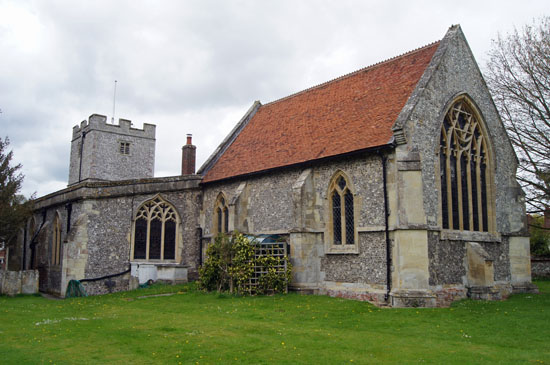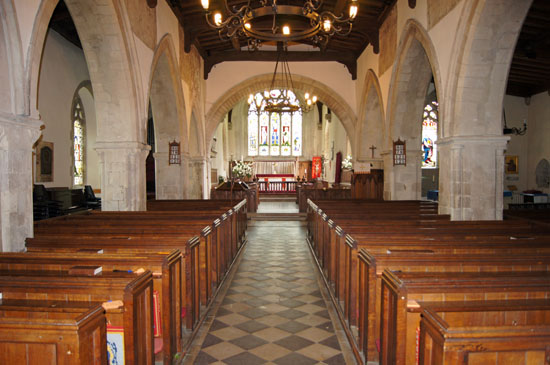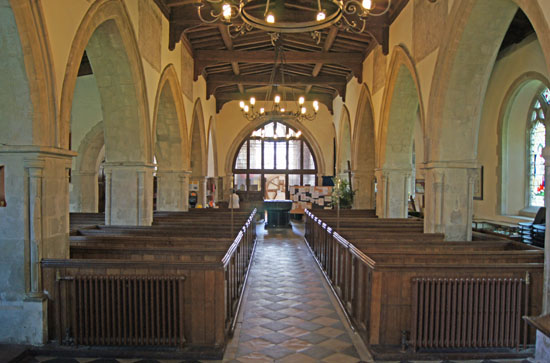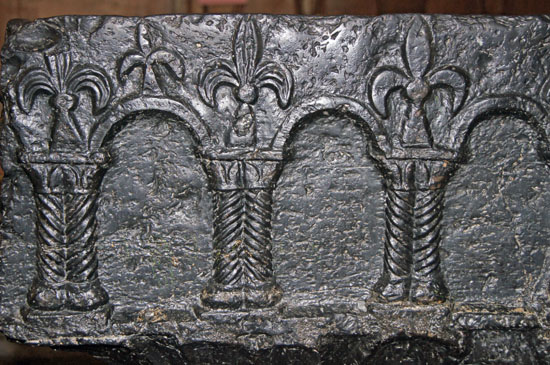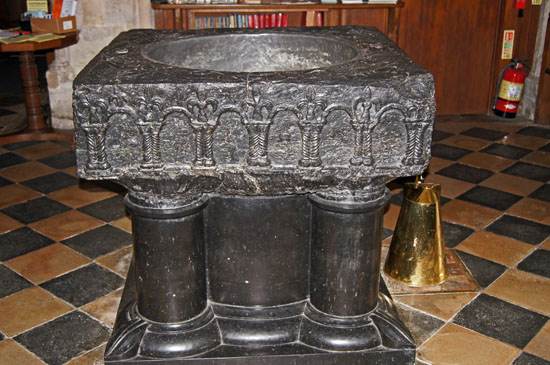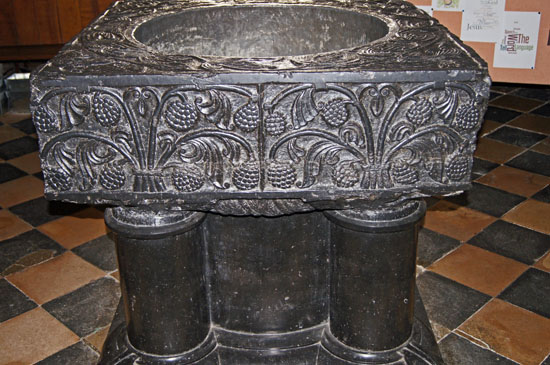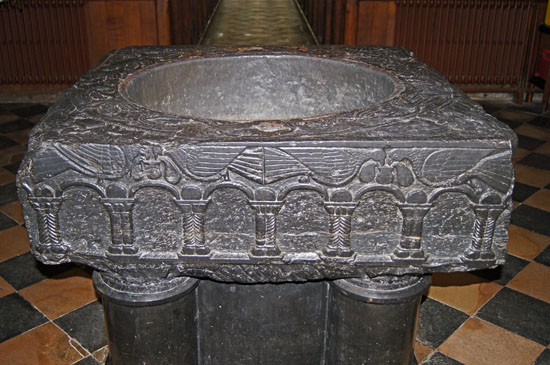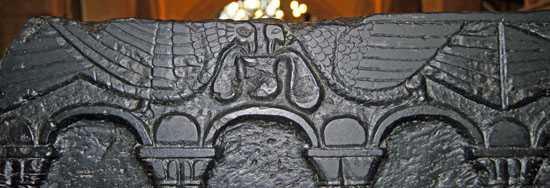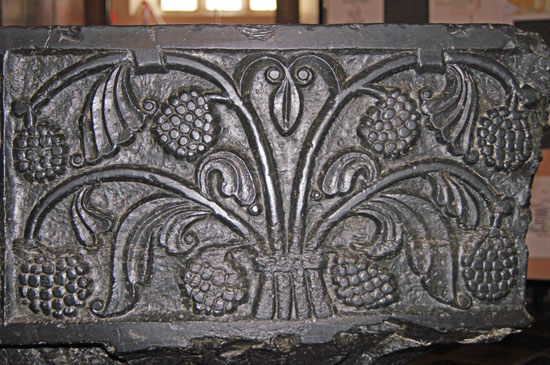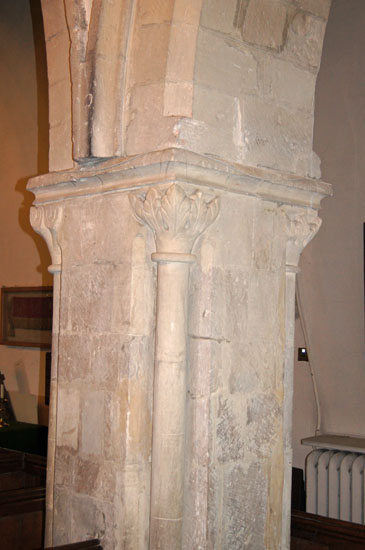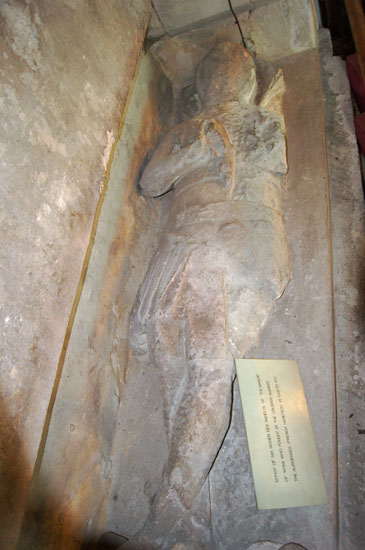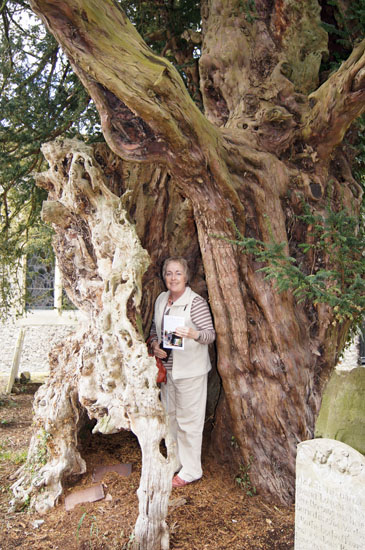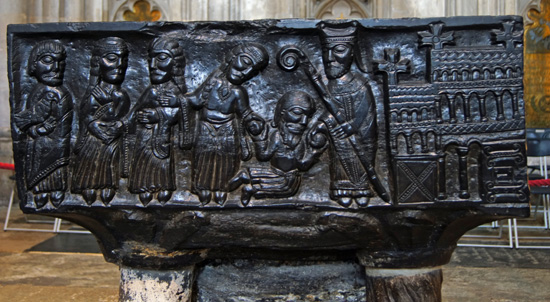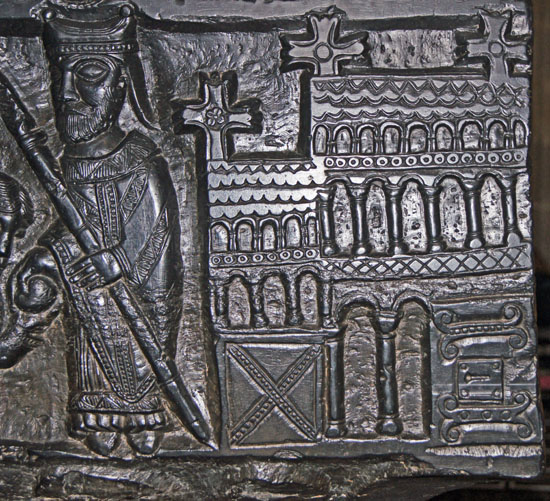|
Alphabetical List |
|
|
|
|
|
|
|
County List and Topics |
|
|
|
Please sign my Guestbook and leave feedback |
|
|
||||||||||||||||||||||
|
The rest of the church is pleasant but unremarkable, with the usual unruly patchwork of Gothic windows, some of them quite modern. Apart from the font, one of the most interesting features is a Crusader tomb in the Lady Chapel which dates from about 1330. Don’t, however, conjure up a mental picture of some brave soldier making the arduous journey to the Holy Land to face “Saracens” and Mamelukes. This soldier is believed to be Sir Roger des Andelys of Wyke Manor who was killed in the Crusade against the “heretic” Cathar (or “Albigensian”) sect in Southern France! If you know of this Crusade you might feel, as I do, that the participants were somewhat less than heroic - although one has to beware of making judgements 900 years after the event. More about this in the footnote below. So to the font. Tournai Marble comes from quarries around the town of that name which is now in the Walloon area of Belgium. As with many European “marbles” (including, for example, our own Portland Marble) Tournai is in fact a form of limestone. In the c11 Tournai was part of France. The “marble” is bluish-black and would have been transported along the River Scheldt to the sea at Antwerp. The fonts would have been carved in the region and transported as finished products. There are only seven in England. The fact that four of the seven are in Hampshire leads to the conclusion that they were the gift of the wealthy and generous Henry de Blois, Bishop of Winchester (the cathedral itself has a Tournai font) from 1129 to 1171 and grandson of William the Conqueror. There are about 17 in France, 10 in Belgium and just two in Germany. Such bulky artifacts must have presented a considerable transport problem on the overland sections, so perhaps it is unsurprising that there are so few outside France and Belgium. and that those in England are all close to rivers. The Church Guide regards the font as a puzzle asking, very reasonably, why such a rare and expensive treasure should be given to a church that was no more than a Chapel of Ease for the church of Hurstbourne Priors when two of the seven are found in important cathedrals (Lincoln being the other). They suggest that Henry’s special interest in St Mary may have been his motive. It is worth mentioning, however, that the village of Thornton Curtis near the Humber is no bigger than St Mary Bourne and also has a Tournai font - equally a puzzle. The font here at St Mary Bourne is less spectacular than that at nearby Winchester Cathedral (pictures below) or at Thornton Curtis. Two sides are decorated with intertwined vines and grapes; two with “blind arcading” decoration. The surround of the font’s bowl is much wider than on a conventional stone font and this area, especially the corners are also heavily decorated. |
|
|
||||||||||||||||||||||||||||||||||||||||||||||||||||||||||||||||||||||||||||||||||||||||||||||||||||||||||||||||||||||||||||||||||||||||||||||||||||||||||||||||||||||||||||||||||||||||||||||||||||||||||||||||||||||||||||||||||||||||||||||||||||||||||||||||||||||||||||||||||||||||||||||||||||||||||||||||||||||||||||||||
|
|
||||||||||||||||||||||||||||
 |
 |
||
|
|
 |
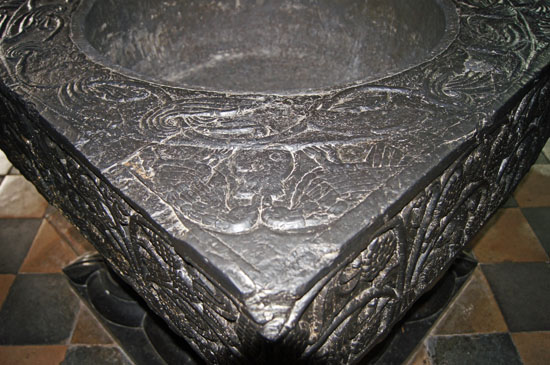 |
||
|
The south east and north west corners continue with the theme of doves sipping - this time from vases rather than cups |
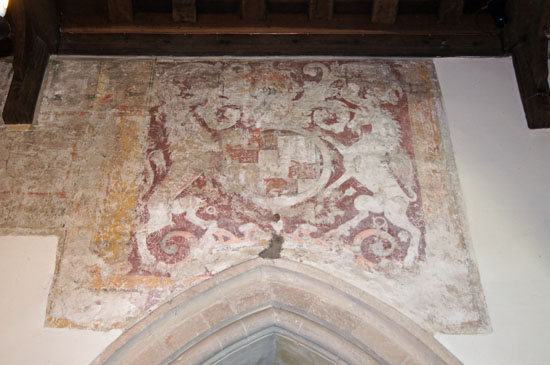 |
 |
|
|
|
|
|
||||||||||||||||||||||||||||||||||||||||
|
The Tournai Font of Winchester Cathedral |
|
The font at Winchester Cathedral - about 16 miles from St Mary Bourne - is very much more elaborate, as you might expect. It shows scenes from the life of St Nicholas. It is worth noting that it is much finer than the one at Lincoln Cathedral which, like nearby Thornton Curtis, is decorated with fantastic birds. |
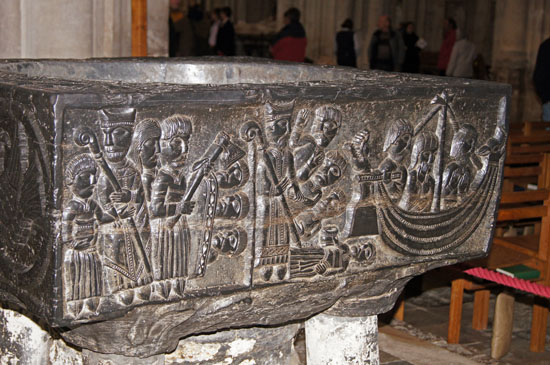 |
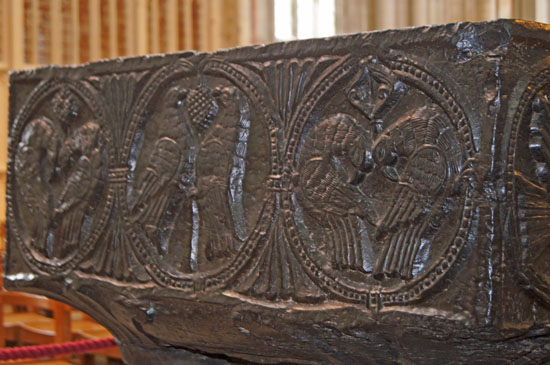 |
||
|
|
||||||||||||||||||||||||
|
Footnote 1 - The Crusade against the Cathars |
|
Even in the bloodstained annals of the mediaeval world, the suppression of the Cathars by fire and sword is a by-word for infamy. Many books have been written about the subject so I will give only give the briefest of accounts to thereby place the death of St Mary Bourne’s “Crusader” into context. Fostered in the city of Albi (hence the alternative name “Albigensians”) Cathars were a “dualist” sect. Put simply, they believed that the visible material world was corrupt and created by the forces of evil. The authority of temporal and, crucially, religious authorities was therefore pointless. Their god ruled the invisible spiritual world. Their god was tolerant and cared nothing for everyday sins in the devilish world. Cathars who died were re-incarnated until such time as they chose to live a life of self-denial. They would then be taken into heaven for eternity as saints. Hell was Earth, not a place of fires, devils and demons as proclaimed by the Catholic Church. Inoffensive enough, you might feel. Indeed, The Cathar lands of southern France seem to have been places of peace and tolerance. The arts flourished and there was a tradition of troubadors and “courtly love”. We should not get carried away into thinking it was some sort of idyll, but by all accounts it was a comparatively civilised society compared with most. But of course, it was contrary to all of the teachings of the Church. Effectively, Catharism thought Catholicism was a great big con trick. They had no need of priests and the Church hierarchy, nor did they see the need to pay tithes and taxes to support the Christian charade. Indeed, their creed was essentially anarchic. Reincarnation implied that the rich today were humble tomorrow and vice-versa, thus undermining the whole feudal hierarchy. It even had implications for the position of women in society. How could one sex be “inferior” if most of them had once been men? Oaths were pointless: how could a man be accountable to his god for an oath made on a corrupt earth? All of this was not only heresy, but socially subversive heresy. It couldn’t be allowed to continue. Public debates were held in Languedoc between Catholic theologians and Cathar “Perfects”. St Bernard of Clairvaux no less - the founder of the Benedictine Orders and the most influential theologian of his time and arch-opponent of Catharism - tried to prove the error of their ways to no avail. Eventually Pope Innocent III declared a crusade to eradicate the Cathars. It will come as a shock to many to know that there was a crusade in Europe and not against infidel Muslims but against “deviant” Frenchmen! Perhaps even more surprising, the war against the Cathars was to last from 1209 to 1229. The war was not just against the poor peasantry. Many of the nobility - particularly the powerful Count Raymond of Toulouse - were Cathar sympathisers and, even if they were not, they had no intention of allowing lords from all over France and the rest of Europe to rampage through their lands. The leader of the Crusaders for much of this time was one Simon de Montfort, the father of the fabled founder of the English parliament. And what a bloody bastard he was. His Wikipaedia entry notes: “He became notorious and feared for his extreme cruelty, massacring whole towns, and for his ‘treachery, harshness, and bad faith.’ In 1210 he burned 140 Cathars in the village of Minerve who refused to give up their faith. In another widely reported incident, prior to the sack of the village of Lastours, he brought prisoners from the nearby village of Bram and had their eyes gouged out and their ears, noses and lips cut off. One prisoner, left with a single good eye, led them into the village as a warning”. Against all the odds, the war was to drag on for 20 years. The savagery of the crusade was sickening. All 20,000 inhabitants of Beziers were massacred. It is the stuff of legend that when a crusader asked how he would know a Cathar from a Catholic the answer given was “Kill them all. God will know his own”. Not only was the war eventually won, but the Church set about eradicating Catharism altogether. To refuse to recant was to be burned alive. The Inquisition with which we are all so familiar was not the Spanish Inquisition as we casually call it: it was set up specifically to condemn the Cathars. It is a fact that after about 1240 not one single Cathar was left alive. This, in short, is the war in which Sir Roger de Andelys took part - an act of church-promoted genocide. It is futile to judge the actions of 900 years ago by the standards of today, Sir Roger will have had his reasons. I for one, though, doubt that he acquired his promised place in Heaven. Whatever he was, he was no hero. To know more of this quite incredible story, I recommend “The Perfect Heresy - The Life and Death of the Cathars” by Steven O’Shea ISBN No 1 86197 270 9. |
|
Footnote 2 - Cathedrals |
|||
|
Having mentioned Winchester Cathedral font on this page, you might wonder why I studiously avoid writing about cathedrals. The simple answer is that I have nothing to say about them that isn’t said in the lavish and colourful guide books that they all produce. People visit cathedrals without any encouragement from myself. My joy is in the humble parish churches with all their quirks and fancies, not in the grandeur and riches of the cathedral. Am I not interested in cathedrals? Yes, of course, and I’ve visited many at home and abroad. I just choose not to write about them! |
|||
